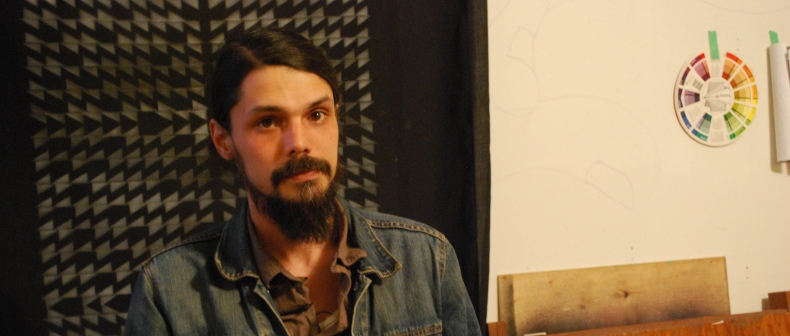
Artist Douglas Brown. Photo by Christian Allaire
Both fashion and art has the tendency to borrow or rather, steal, and so in today’s market, there is no such a thing as an original print, silhouette, embellishment or technique. Inspiration or appropriation, all art is accused of being a thief of culture’s past, in one way or another (see? I just stole a Blondie lyric right there).
In recent terms, Rodarte’s Laura and Kate Mulleavy are under serious fashion fire for using Aboriginal-inspired prints in their fall 2012 collection. Many were outraged that the fashion label used prints with spiritual significance as a means to, essentially, sell product. “It is completely insensitive to Aboriginal art and spirituality and land and how they are inextricably linked,” said Megan Davis, an indigenous Australian lawyer and member of the United Nations Permanent Forum on Indigenous Issues (UNPFII). Mass retailer Urban Outfitters also participated in this Aboriginal plagiarism act: they used “Navajo” to describe their aboriginal print-inspired line and, then, were sued by the Navajo Nation for trademark infringement and violating the federal Indian Arts and Crafts Act (which makes it illegal for merchandise to suggest it was made by American Indians when it was, in fact, not.) Proenza Schouler also created a Navajo-inspired collection back in fall 2011, where they created this weird and offensive fashion video featuring distorted models in Native American headdresses. Fashion loves a good revival, it seems, but at the cost of serious cultural respect.
But retailers are not alone. For what seems like ever, fashion journalists and art critics alike have been participating in this cultural rip-off as well, citing pieces as “tribal-inspired” or “safari-inspired” but failing to realize how detrimental or confusing that term really is. Oh look, says said fashion journo, that jacket is made of a kente cloth. It must be ethnic inspired. That is, of course, an exaggeration (and not an untrue one), but you catch my drift when I say that cultural groups are being stripped to their bare minimum and sold in their most blatant form. ……
So why the increase in these Aboriginal inspired creations via fashion and art, among others? And what do Aboriginal artists, who in fact do authentically create art based on their own culture, think of this? I sat down with Douglas Brown, an aboriginal artist in Toronto, to discuss this increasingly off-putting issue. Along with having his worked showcased in Toronto’s Gladstone Hotel and other art shows, Brown believes people who rip-off Aboriginal culture are, simply, “trying too hard.” And understatement of the year goes to ….
Artwork by Douglas Brown. Photo by Christian Allaire
You make a lot of aboriginal-inspired art. Did you grow up around that culture?
My father is native and black, and my mother is Scottish. And I look Mexican. [Laughs] But no, never. I have memories of my aboriginal family when I was younger, but I was separated from that part of my family since I was really young. I don’t pretend to know much about that background because I really didn’t know my biological father. But I know that it’s in me, and that I am aboriginal. Of course it inspires me, because it’s something that I’ve always been interested in, but for me it’s very much the unknown. I’m exploring it by taking inspiration from something that’s part of me.
What do you think attracts people to aboriginal culture? We’re seeing a lot of artists and designers take cue from it, and maybe not in the best way possible.
I think it’s because it’s so unexplored. It’s the unknown to us still. Canada is a pretty young country, and I feel like they haven’t really tought that part of Canada’s history yet. So to a lot of people, especially outsiders, it’s still the unknown. I think the more and more people find out about native culture, the more they find out that it makes sense. The views that aboriginal people have and have always had is a new thing to people, but when you read about it and some of their ideologies, it totally makes more sense than all this other stuff we think we know about it.
Artwork by Douglas Brown. Photo by Christian Allaire
You see a lot of artists or designers being inspired by aboriginal art, but they’ll often do it in a very stereotypical way. Your work obviously doesn’t do that — how do you stray away from being too literal?
I’m not really trying to do it that way; it’s just the way it’s coming out. Maybe I can hide behind the fact that I’m part native, but I’ve never tried to claim that that’s where my art is coming from. I just do my own thing regardless of what people are going to say or think. A lot of that time when you see that stereotypical, cliché-type shit, it’s because the person is trying too hard. You see sincerity, especially in artwork, you can tell if someone is sincere about what they’re doing or if they’re just doing something for the fact that they like native stuff and want to copy it. I never really try to approach it like ‘okay, today I’m going to make Scottish-inspired art!’ or ‘I’m going to make African-inspired art!’
Why do you think aboriginal people get so offended when non-aboriginals take inspiration from their culture? Are artists being insensitive in their interpretation?
It’s hard for me to say why they would be offended, just because I’ve never been offended. Obviously the people are getting offended because of something deeper than just the art. Art is entertainment; you make some cool shit for people to be entertained and to hold their attention for more than 30 seconds at a time. So it must come from a deeper-rooting issue. A lot of native artists have been doing art forever and then they just see someone copying it and making money, so I can understand their frustration there.
Artwork by Douglas Brown. Photo by Christian Allaire
That being said, do you think there is a significant difference between aboriginal people making aboriginal art and non-aboriginal people making aboriginal art? Are both accepteable?
Everything is a hybrid now. Especially in Canada, I’m sure half the kids in Toronto are some kind of native or this, that and the next thing. You might not be aboriginal, but you grew up in this culture where aboriginal culture was pumped into your face as well as others like asian culture. It’s almost like this hyper culture of mashed up different things, so I don’t think anyone owns something specific. We live in a society that is exposed to so many different cultures that it’s natural for us to be inspired by a multicultural sense of living. You talk to anyone who has been to Toronto and they say ‘I can’t believe how multicultural it is.’ And you’re like, dude, you’re from New York — what are you talking about? And they’re like ‘yeah it’s multicultural, but it’s segregated still.’
Since so many mass retailers are ripping off original art, it must be hard to sustain yourself as an artist.
For a long time I was of the mentality like ‘fuck, I need to work, make money, pay bills.’ I was scared to take a chance on myself and I didn’t have confidence in what I was doing. It wasn’t until recently where I started putting stuff out in the world, and it just clicked. I’m like what was I doing? So now I’m hoping that, as long as I’m sincere about this, it shows through and people will appreciate it. I’m really happy not working and just doing this, but being happy doesn’t necessarily pay the bills.
Douglas Brown’s studio. Photo by Christian Allaire________
Christian Allaire writes on style for Toronto Standard. Follow his tweets here: @chrisjallaire.
For more, follow us on Twitter @TorontoStandard and subscribe to our newsletter.
____














